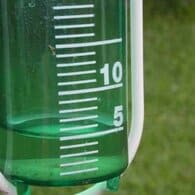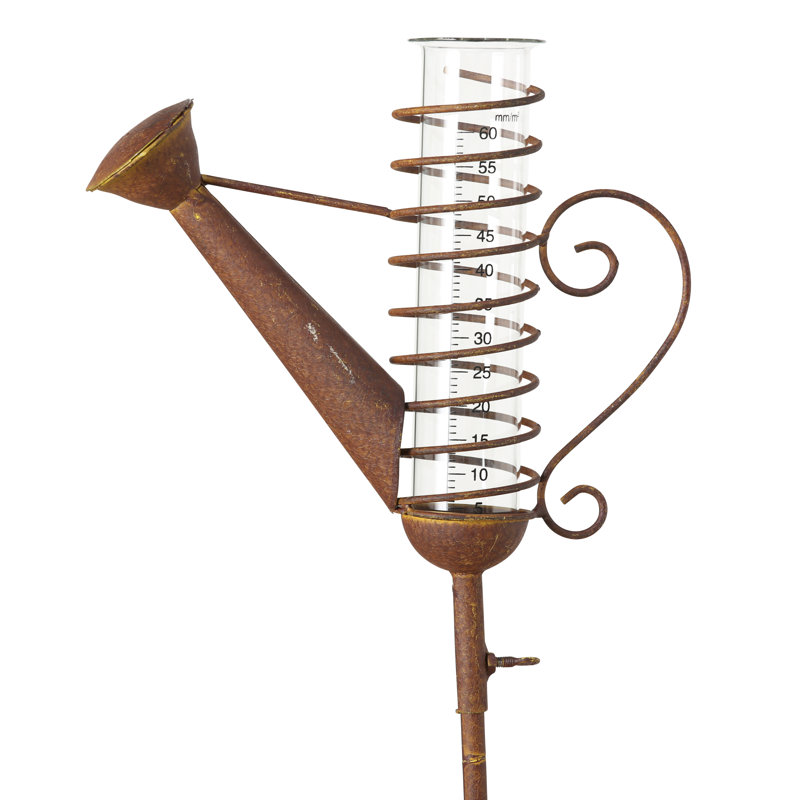Theperfectgarden.co.uk may earn a small commission (at no extra cost to the user) from Amazon and other online retailers if a purchase is made after clicking a link. I appreciate your continuing support.
What is a Rain Gauge and How Does it Work?
A rain gauge is a device which is used to record and track the volume of rainfall and precipitation over a fixed period of time. Used by meteorologists, hydrologists and gardeners alike. Rain gauges are simple receptacles with a scale marked on the side for measuring rainfall in millilitres.
In the UK, I would like to say we are used to a lot of rain but as any gardener knows, we get lots of rain… It’s just usually at the wrong time!
Why do I Need a Rain Gauge?
We spend all winter working on our lawns and borders wishing for dry weather, only to get to the summer, when we pray for rain to water our lawns and plants. How many times have you put fertiliser on the lawn in the hope that forecast rain actually falls, especially overnight?
Rain gauges are a useful way of telling how much rain has actually fallen. This can take the guesswork out of whether you need to water a lawn or plants in a border.
Now, I say “plants in borders” because, in my experience, there is rarely enough rainfall in the summer months that waters plants in pots sufficiently. The surface of pots are generally shaded by leaves and flowers and although the raindrops can make their way through to the soil beneath, there is not always a sufficient amount to make its way down to the roots, where it’s needed.
That said, plants left in pots over winter aren’t quite so protected and can suffer from waterlogging if they don’t have sufficient drainage. Whoever said gardening was more of a balancing act, wasn’t far wrong!
What Exactly is a Rain Gauge?
Apologies for wandering off the beaten track but watering the garden is one of the hardest jobs to get right!
So what exactly is a rain gauge? They are simple receptacles that collect rain and they come in all shapes and sizes. There are even novelty rain gauges which can add a bit of humour to your garden. The only important part is that the receptacle has a correctly marked scale, that measures how much rain has fallen.
How do Rain Gauges Measure?
According to the MET office, the two most common rain gauges are the tipping bucket gauge and the storage gauge. Not only is it important to see how much rain has been collected but it is also important to record the period of time over which the rain fell and filled the receptacle.
The tipping bucket gauge is an automatic measure, with a mechanism that records the time the storage element is filled by an increment of 0.2mm.
Storage gauges need to be collected and then emptied into a separate rain measure after a specified amount of time.
What is the Unit of a Rain Gauge?

The measurement unit of rainfall intensity is linear depth per hour, usually in millimetres per hour (mm h–1). Rainfall intensity is normally measured or derived over one-minute time intervals due to the high variability of intensity from minute to minute.
Measurement of precipitation – WMO Library – World Meteorological
Are Rain Gauges Easy to Read?
Rain gauges that can be purchased easily online are easy to read and are perfectly adequate for recording rainfall. A measuring scale is boldly printed on the side of the rain gauge.
Where Should I Put my Rain Gauge?
For your rain gauge to be in any way effective, you need to position it in an open area in the path of rainfall. Do not choose the driest spot in your garden. It is also advisable not to put your rain gauge under a tree or near a wall.
Trees can block and trap water, releasing it at various points – not giving your rain gauge an accurate picture of when peak rain times are. Additionally, walls can shelter the rain gauge from falling rain.
Do Rain Gauges Survive the Winter?
Rain gauges do survive the winter! Most are simple, so are tough to actually break.
It is worth noting however that the MET office warns against trusting your rain gauge during winter, particularly during snowy periods. Excess snow can clog up the gauge, making any reading from it in those periods likely to be faulty at best.
The Best Rain Gauges UK
There are several different types and materials of rain gauge out there, from digital weather stations to simple rain cones at a budget price.
WiFi Rain Gauges and Weather Stations
It should not be a surprise that this is an expensive option! However, these weather stations do allow you to track rainfall, wind direction, humidity and air pressure, allowing intricate garden optimisation. You can also control your watering system remotely at peak rainfall times using this and its Wi-Fi features.
Novelty Rain Gauges
Not interested in all of that Wi-Fi trickery? Want to make your garden look a bit more interesting? or looking for an unusual garden gift. Check out this beautiful piece from Brambly Cottage. Shaped with a watering can design, this will fit right into any garden.
Simple Rain Gauges
If you want a simple rain gauge, there are plenty to suit small budgets.










